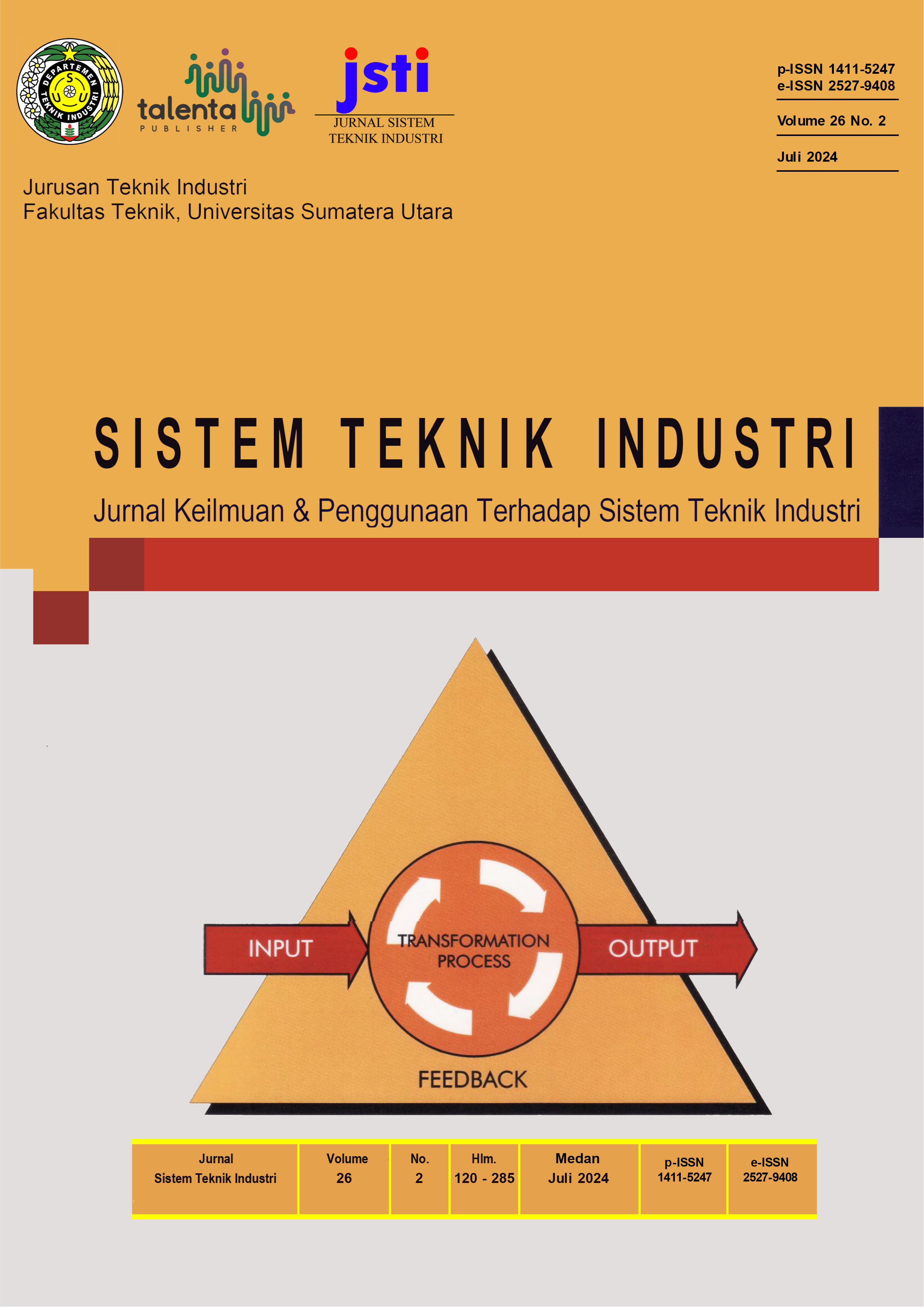Implementation of Long Short-Term Memory Network for Predicting The Cocoa Crop Yield
DOI:
https://doi.org/10.32734/jsti.v26i2.15359Keywords:
Coefficient of Determination, Crop Yield, Forecasting, Long Short-Term Memory Network, RegressionAbstract
Forecasting models with high accuracy become more important during uncertain conditions, such as climate change, that could have a high effect. The forecast model's accuracy in predicting cocoa crop yield must be high to determine decision-making in management. Seven different potential predictor variables have been analyzed in this research to see the influence of cocoa crop yield. Using a scatter plot diagram, six of seven variables, relative humidity, maximum temperature, minimum temperature, evapotranspiration, rainfall, and soil moisture, are proven to influence cocoa crop yield. Then, those datasets are divided into training and validation sets using multiple linear regression analysis and a Long Short-Term Memory (LSTM) network. The output model of those methods is assessed using two metrics: coefficient of determination and Root Means Square Error (RMSE). From those model performance metrics, LSTM outperformed multiple linear regression analysis. LSTM has an R-square of 98% and an RMSE of 0.3 while multiple linear regression just reached 82% of the R-square and 2.57 of the RMSE. The LSTM model has been proven to be valid.
Downloads
References
A. Krähmer et al., “Fast and neat - Determination of biochemical quality parameters in cocoa using near infrared spectroscopy,†Food Chem., vol. 181, no. February, pp. 152–159, 2015, doi: 10.1016/j.foodchem.2015.02.084.
S. K. Dermoredjo, S. M. Pasaribu, D. H. Azahari, and E. S. Yusuf, “Indonesia’s coffee and cocoa agribusiness opportunities in Regional Comprehensive Economic Partnership trade cooperation,†IOP Conf. Ser. Earth Environ. Sci., vol. 892, no. 1, 2021, doi: 10.1088/1755-1315/892/1/012071.
I. M. Fahmid, H. Harun, M. M. Fahmid, Saadah, and N. Busthanul, “Competitiveness, production, and productivity of cocoa in Indonesia,†IOP Conf. Ser. Earth Environ. Sci., vol. 157, no. 1, 2018, doi: 10.1088/1755-1315/157/1/012067.
M. S. Dr. Ir. Anna A. Susanti and M. A. Rhendy Kencana Putra Widiyanto, S.Si, “Outlook Komoditas Perkebunan Kakao,†Outlook Komod. Perkeb. Kakao, vol. 4, no. Ii, pp. 29–34, 2022.
E. O. Ajayi et al., “We are IntechOpen , the world ’ s leading publisher of Open Access books Built by scientists , for scientists TOP 1 %,†Intech, vol. 11, no. tourism, p. 13, 2016, [Online]. Available: https://www.intechopen.com/books/advanced-biometric-technologies/liveness-detection-in-biometrics
S. S. Olofintuyi, E. A. Olajubu, and D. Olanike, “An ensemble deep learning approach for predicting cocoa yield,†Heliyon, vol. 9, no. 4, p. e15245, 2023, doi: 10.1016/j.heliyon.2023.e15245.
H. Mo, Y. Zhang, Y. Liu, and Y. Zheng, “Prediction of rice yield based on LSTM long short term memory network,†J. Phys. Conf. Ser., vol. 1952, no. 4, 2021, doi: 10.1088/1742-6596/1952/4/042033.
K. Gavahi, P. Abbaszadeh, and H. Moradkhani, “DeepYield: A combined convolutional neural network with long short-term memory for crop yield forecasting,†Expert Syst. Appl., vol. 184, no. May, p. 115511, 2021, doi: 10.1016/j.eswa.2021.115511.
M. Mukhlis, A. Kustiyo, and A. Suharso, “Peramalan Produksi Pertanian Menggunakan Model Long Short-Term Memory,†Bina Insa. Ict J., vol. 8, no. 1, p. 22, 2021, doi: 10.51211/biict.v8i1.1492.
G. Niedbała, “Application of multiple linear regression for multi-criteria yield prediction of winter wheat,†J. Res. Appl. Agric. Eng., vol. 63, no. 4, p. 125, 2018.
V. Sellam and E. Poovammal, “Prediction of crop yield using regression analysis,†Indian J. Sci. Technol., vol. 9, no. 38, 2016, doi: 10.17485/ijst/2016/v9i38/91714.
A. Assa, Rosniati, and M. R. Yunus, “Effects of cocoa clones and fermentation times on physical and chemical characteristics of cocoa beans (Theobroma cacao L.),†IOP Conf. Ser. Mater. Sci. Eng., vol. 528, no. 1, pp. 1–7, 2019, doi: 10.1088/1757-899X/528/1/012079.
A. Wahyu Soesilo, I. A. Sari, and . I., “Yield Performance of Locally Selected Cocoa Clones in North Luwu,†Pelita Perkeb. (a Coffee Cocoa Res. Journal), vol. 31, no. 3, pp. 152–162, 2015, doi: 10.22302/iccri.jur.pelitaperkebunan.v31i3.172.
G. Civeira, “Introductory Chapter: Soil Moisture. We are IntechOpen , the world ’ s leading publisher of Open Access books Built by scientists , for scientists TOP 1 %,†Intech, pp. 1–3, 2019, [Online]. Available: http://dx.doi.org/10.1039/C7RA00172J%0Ahttps://www.intechopen.com/books/advanced-biometric-technologies/liveness-detection-in-biometrics%0Ahttp://dx.doi.org/10.1016/j.colsurfa.2011.12.014
A. Herawati, Rahayu, G. Herdiansyah, Supriyadi, and R. Wijayanti, “The impact of climate change on land suitability and cocoa productivity in Tulakan District, Pacitan Regency,†IOP Conf. Ser. Earth Environ. Sci., vol. 824, no. 1, 2021, doi: 10.1088/1755-1315/824/1/012028.
S. Baja, Harli, L. Asrul, R. Padjung, and R. Neswati, “The Effect of Soil Chemicals on Cocoa Productivity in West Sulawesi,†IOP Conf. Ser. Earth Environ. Sci., vol. 921, no. 1, 2021, doi: 10.1088/1755-1315/921/1/012046.
H. Wijayati and H. Haqqi, “The Indonesian Global Cocoa Chain’s Position in the Pandemic Era,†Int. J. Soc. Sci. Econ. Art, vol. 12, no. 1, pp. 10–21, 2022, doi: 10.35335/ijosea.v12i1.75.
D. Arianto, Z. Basri, and M. Bustami, “Induksi kalus dua klon kakao (Theobroma cacao L.) unggul Sulawesi pada berbagai konsentrasi 2,4 dichlorophenoxy acetic acid secara in vitro,†e-J. Agrotekbis, vol. 1, no. 3, pp. 211–220, 2013.
A. W. Susilo, B. Setyawan, and I. A. Sari, “Yield Performance of Some Promising Cocoa Clones (Theobroma cacao L.) at Dry Climate Condition,†Pelita Perkeb. (a Coffee Cocoa Res. Journal), vol. 36, no. 1, pp. 24–31, 2020, doi: 10.22302/iccri.jur.pelitaperkebunan.v36i1.372.
M. Sundari and P. R. Sihombing, “The Influence of Climate Factors on Cocoa Productivity in Sulawesi, 2019,†Param. J. Stat., vol. 1, no. 1, pp. 21–30, 2021, doi: 10.22487/27765660.2021.v1.i1.15444.
W. Niether, L. Armengot, C. Andres, M. Schneider, and G. Gerold, “Shade trees and tree pruning alter throughfall and microclimate in cocoa (Theobroma cacao L.) production systems,†Ann. For. Sci., vol. 75, no. 2, Jun. 2018, doi: 10.1007/s13595-018-0723-9.
L. S. Fraga Junior, L. M. Vellame, A. S. de Oliveira, and V. P. da Silva Paz, “Transpiration of young cocoa trees under soil water restriction,†Sci. Agric., vol. 78, no. 2, 2020, doi: 10.1590/1678-992x-2019-0093.
F. Yoroba et al., “Evaluation of Rainfall and Temperature Conditions for a Perennial Crop in Tropical Wetland: A Case Study of Cocoa in Côte d’Ivoire,†Adv. Meteorol., vol. 2019, 2019, doi: 10.1155/2019/9405939.
B. W. Farhanandi and N. K. Indah, “Karakteristik Morfologi dan Anatomi Tanaman Kakao (Theobroma cacao L.) yang Tumbuh pada Ketinggian Berbeda,†LenteraBio Berk. Ilm. Biol., vol. 11, no. 2, pp. 310–325, 2022, doi: 10.26740/lenterabio.v11n2.p310-325.
Z. Qiu et al., “Analysis of the accuracy of using ERA5 reanalysis data for diagnosis of evaporation ducts in the East China Sea,†Front. Mar. Sci., vol. 9, no. January, pp. 1–14, 2023, doi: 10.3389/fmars.2022.1108600.
H. Liang, “Influence mechanism of development effect of forest ecotourism in China,†For. Stud., vol. 64, no. 2010, pp. 93–100, 2016, doi: 10.1515/fsmu-2016-0006.
G. M. Tinungki, “The analysis of partial autocorrelation function in predicting maximum wind speed,†IOP Conf. Ser. Earth Environ. Sci., vol. 235, no. 1, 2019, doi: 10.1088/1755-1315/235/1/012097.
H. M. Maheshwarappa and S. Majumder, “Interpretation of p-value: The Correct Way!,†Indian J. Respir. Care, vol. 12, no. 1, pp. 1–2, 2023, doi: 10.5005/jp-journals-11010-1026.
J. I. Daoud, “Multicollinearity and Regression Analysis,†J. Phys. Conf. Ser., vol. 949, no. 1, 2018, doi: 10.1088/1742-6596/949/1/012009.
R. Mopuri, S. G. Kakarla, S. R. Mutheneni, M. R. Kadiri, and S. Kumaraswamy, “Climate based malaria forecasting system for Andhra Pradesh, India,†J. Parasit. Dis., vol. 44, no. 3, pp. 497–510, 2020, doi: 10.1007/s12639-020-01216-6.
M. K. Wisyaldin, G. M. Luciana, and H. Pariaman, “Pendekatan LSTM untuk Memprediksi Kondisi Motor 10 kV pada PLTU Batubara,†Kilat, vol. 9, no. 2, pp. 311–318, 2020, [Online]. Available: http://jurnal.itpln.ac.id/kilat/article/view/997%0Ahttps://jurnal.itpln.ac.id/kilat/article/download/997/775
J. Hernández, D. López, and N. Vera, “Primary user characterization for cognitive radio wireless networks using long short-term memory,†Int. J. Distrib. Sens. Networks, vol. 14, no. 11, 2018, doi: 10.1177/1550147718811828.
C. Jiang et al., “A mixed deep recurrent neural network for MEMS gyroscope noise suppressing,†Electron., vol. 8, no. 2, pp. 1–14, 2019, doi: 10.3390/electronics8020181.
C. C. Liu, T. Wu, and C. He, “State of health prediction of medical lithium batteries based on multi-scale decomposition and deep learning,†Adv. Mech. Eng., vol. 12, no. 5, 2020, doi: 10.1177/1687814020923202.
J. Brownlee, “Long Short-Term Memory Networks With Python,†Mach. Learn. Mastery With Python, vol. 1, no. 1, p. 228, 2017.
T. Chai and R. R. Draxler, “Root mean square error (RMSE) or mean absolute error (MAE)? -Arguments against avoiding RMSE in the literature,†Geosci. Model Dev., vol. 7, no. 3, pp. 1247–1250, 2014, doi: 10.5194/gmd-7-1247-2014.
A. Jadon, A. Patil, and S. Jadon, “A Comprehensive Survey of Regression Based Loss Functions for Time Series Forecasting,†2022, [Online]. Available: http://arxiv.org/abs/2211.02989
D. Chicco, M. J. Warrens, and G. Jurman, “The coefficient of determination R-squared is more informative than SMAPE, MAE, MAPE, MSE and RMSE in regression analysis evaluation,†PeerJ Comput. Sci., vol. 7, pp. 1–24, 2021, doi: 10.7717/PEERJ-CS.623.
R. L. Sapra, “Using R2 with caution,†Curr. Med. Res. Pract., vol. 4, no. 3, pp. 130–134, 2014, doi: 10.1016/j.cmrp.2014.06.002.
R. J. Hyndman and G. Athanasopoulos, “Athanasopoulos, George_ Hyndman, Rob J. - Forecasting_ Principles and Practice (2018).pdfâ€.
E. S. Ahmed, E. Raheem, and S. Hossain, “Absolute Penalty Estimation,†Int. Encycl. Stat. Sci., pp. 1–3, 2011, doi: 10.1007/978-3-642-04898-2_102.
A. Field, “Discovering Statistic Using IBM SPSS Statistic 5th,†Dk, vol. 53, no. 9, pp. 1689–1699, 2017.
T. K. Igawa, P. M. de Toledo, and L. J. S. Anjos, “Climate change could reduce and spatially reconfigure cocoa cultivation in the Brazilian Amazon by 2050,†PLoS One, vol. 17, no. 1 January, pp. 1–14, 2022, doi: 10.1371/journal.pone.0262729.
E. Santosa, G. P. Sakti, M. Z. Fattah, S. Zaman, and A. Wahjar, “Cocoa Production Stability in Relation to Changing Rainfall and Temperature in East Java, Indonesia,†J. Trop. Crop Sci., vol. 5, no. 1, pp. 6–17, 2018, doi: 10.29244/jtcs.5.1.6-17.
W. Niether et al., “The effect of short-term vs. long-term soil moisture stress on the physiological response of three cocoa (Theobroma cacao L.) cultivars,†Plant Growth Regul., vol. 92, no. 2, pp. 295–306, 2020, doi: 10.1007/s10725-020-00638-9.
J. Richetti, F. I. Diakogianis, A. Bender, A. F. Colaço, and R. A. Lawes, “A methods guideline for deep learning for tabular data in agriculture with a case study to forecast cereal yield,†Comput. Electron. Agric., vol. 205, no. December 2022, 2023, doi: 10.1016/j.compag.2023.107642.
S. Khaki, L. Wang, and S. V. Archontoulis, “A CNN-RNN Framework for Crop Yield Prediction,†Front. Plant Sci., vol. 10, no. January, pp. 1–14, 2020, doi: 10.3389/fpls.2019.01750.
M. Shahhosseini, G. Hu, S. Khaki, and S. V. Archontoulis, “Corn Yield Prediction With Ensemble CNN-DNN,†Front. Plant Sci., vol. 12, no. August, pp. 1–13, 2021, doi: 10.3389/fpls.2021.709008.
W. W. Guo and H. Xue, “Crop yield forecasting using artificial neural networks: A comparison between spatial and temporal models,†Math. Probl. Eng., vol. 2014, 2014, doi: 10.1155/2014/857865.
Downloads
Published
How to Cite
Issue
Section
License
Copyright (c) 2024 TALENTA Publisher Universitas Sumatera Utara

This work is licensed under a Creative Commons Attribution-ShareAlike 4.0 International License.
The Authors submitting a manuscript do so on the understanding that if accepted for publication, the copyright of the article shall be assigned to TALENTA Publisher Universitas Sumatera Utara as the publisher of the journal.
Copyright encompasses the rights to reproduce and deliver the article in all forms and media. The reproduction of any part of this journal, its storage in databases, and its transmission by any form or medium will be allowed.



















